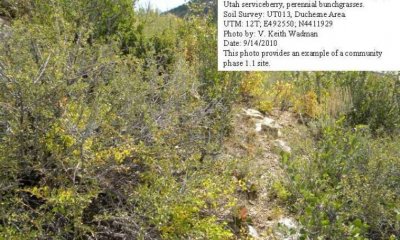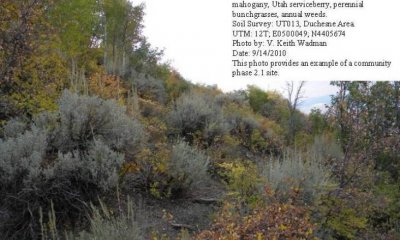
Mountain Very Steep Stony Loam (browse)
Scenario model
Current ecosystem state
Select a state
Management practices/drivers
Select a transition or restoration pathway
-
Transition T1A
drought and improper livestock grazing
More details -
No transition or restoration pathway between the selected states has been described
Target ecosystem state
Select a state
Description
This state describes the biotic communities that may become established on this ecological site if all successional sequences are completed under natural disturbance conditions. Species composition is generally dominated by a mixture of deciduous and non-deciduous shrubs with alderleaf mountain mahogany, chokecherry and mountain big sagebrush dominating. Other important shrubs include Utah serviceberry, bitterbrush and mountain snowberry. Perennial herbaceous species occurrence is directly related to canopy density with bluebunch wheatgrass, Letterman's needlegrass and geyer's sedge being the most common species.
The primary disturbance mechanisms are overstory canopy density, weather fluctuations, and fire or lack of fire. The Reference State is self-sustaining and resistant to change due to a high resistance to natural disturbances and a high resilience following those disturbances. When natural disturbances occur, the rate of recovery can be quite variable. Two distinct community phases are observed and are described in this Reference State. They are the herbaceous shrub and the mountain big sagebrush phases.
Reference State: Plant communities influenced by shrub canopy density, long-term weather fluctuations, and periodic fire.
Indicators: A community dominated by alderleaf mountain mahogany, chokecherry and mountain big sagebrush. The density of the overstory canopy determines the amount and composition of the other native perennial grasses, grass-likes and forbs that may be present.
Feedbacks: Natural fluctuations in weather patterns that allow for a self sustaining mixed shrub and native grass and grasslike community. Insect herbivory, more frequent fires, or other disturbances that may allow for the establishment of invasive species.
At-risk Community Phase: All communities are at risk when native plants are stressed and nutrients become available for invasive plants to establish.
Trigger: The establishment of invasive plant species
Submodel
Description
The current potential state is similar to the Reference State, however minor amounts of invasive species may now present in all community phases. This state describes the biotic communities that may become established on this ecological site if all successional sequences are completed under natural disturbance conditions.
The current potential state is generally dominated by a mixture of deciduous and non-deciduous shrubs with alderleaf mountain mahogany, chokecherry and mountain big sagebrush dominating. Other important shrubs include Utah serviceberry, bitterbrush and mountain snowberry. Perennial herbaceous species occurrence is directly related to canopy density with bluebunch wheatgrass, Letterman's needlegrass and geyer's sedge being the most common species. Cheatgrass and non-native annual forbs could potentially be present in both community phases but this occurrence has not yet been well documented. Areas disturbed by road building and mining are most likely to allow this invasion to occur.
The primary disturbance mechanisms are overstory canopy density, weather fluctuations and fire or lack of fire. The current potential state is still self-sustaining but has a lower resistant to change due to a reduced resistance to disturbances. When disturbances do occur, the rate of recovery can be highly variable.
Current Potential State: Plant communities influenced by shrub canopy density, long term weather fluctuations, and periodic fire.
Indicators: A community dominated by alderleaf mountain mahogany, chokecherry and mountain big sagebrush. The density of the overstory canopy determines the amount and composition of the other native and non-native grasses, grass-likes and forbs that may be present.
Feedbacks: Natural fluctuations in weather patterns that allow for a self sustaining mixed shrub and native grass and grasslike community. Insect herbivory, more frequent fires, or other disturbances that may allow for the development of invasive species.
At-risk Community Phase: All communities are at risk when native plants are stressed and nutrients become available for invasive plants to increase.
Trigger: The increase of invasive plant species.
Submodel
Mechanism
This transitional pathway occurs when drought and improper livestock grazing causes the perennial herbaceous community to become significantly reduced, allowing non-native species such as cheatgrass, alyssum, Russian thistle and other invasive weeds the opportunity to become established. Green rabbitbrush may also increase during this time. Once invasive species occupy the site, a threshold has been crossed. Little evidence exists to verify that this transition is common. Invaded sites are likely present but are of small extent.
Model keys
Briefcase
Add ecological sites and Major Land Resource Areas to your briefcase by clicking on the briefcase (![]() ) icon wherever it occurs. Drag and drop items to reorder. Cookies are used to store briefcase items between browsing sessions. Because of this, the number of items that can be added to your briefcase is limited, and briefcase items added on one device and browser cannot be accessed from another device or browser. Users who do not wish to place cookies on their devices should not use the briefcase tool. Briefcase cookies serve no other purpose than described here and are deleted whenever browsing history is cleared.
) icon wherever it occurs. Drag and drop items to reorder. Cookies are used to store briefcase items between browsing sessions. Because of this, the number of items that can be added to your briefcase is limited, and briefcase items added on one device and browser cannot be accessed from another device or browser. Users who do not wish to place cookies on their devices should not use the briefcase tool. Briefcase cookies serve no other purpose than described here and are deleted whenever browsing history is cleared.
Ecological sites
Major Land Resource Areas
The Ecosystem Dynamics Interpretive Tool is an information system framework developed by the USDA-ARS Jornada Experimental Range, USDA Natural Resources Conservation Service, and New Mexico State University.






